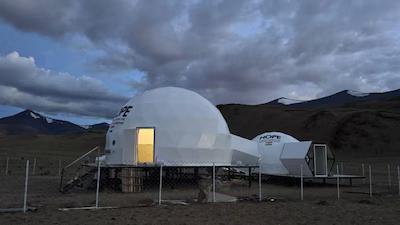
ISRO Sets Up Station in Ladakh to Simulate Life on Moon & Mars
The Indian Space Research Organisation (ISRO) has taken a significant step towards its ambitious plans to explore the Moon and Mars by setting up the Himalayan Outpost for Planetary Exploration (HOPE) in Ladakh’s Tso Kar Valley. The station, which is designed to simulate life on the lunar and Martian surfaces, will test life-support systems for future missions to these celestial bodies.
Located in the Tso Kar Valley, the HOPE station is situated at an altitude of over 15,000 feet above sea level. The valley was chosen for its unique environment, which is similar to the Martian surface. The area is characterized by high UV radiation, low atmospheric pressure, extreme cold, and saline permafrost, making it an ideal location for testing the endurance of life-support systems for future planetary missions.
The ISRO has planned a 10-day simulation mission at the HOPE station, which will be undertaken by two crew members from August 1 to 10. During this period, the crew will conduct various tests to evaluate the performance of the life-support systems, including air, water, and food supply, as well as communication and power generation.
The HOPE station is equipped with state-of-the-art facilities to simulate the harsh conditions found on the Moon and Mars. The station’s life-support systems are designed to operate autonomously for extended periods, and the crew will have to rely on these systems to survive during their stay at the facility.
The ISRO’s decision to set up the HOPE station in Ladakh’s Tso Kar Valley is seen as a strategic move to prepare for its future planetary missions. The organisation is planning to send its first manned mission to space by 2022, and the HOPE station will play a crucial role in testing the life-support systems for this mission.
The HOPE station is also expected to provide valuable insights into the challenges of long-duration spaceflight, which is a critical aspect of deep space exploration. The ISRO is planning to send its first mission to Mars in 2022, and the HOPE station will help the organisation to better understand the challenges of sending humans to the Red Planet.
The ISRO has been working towards its goal of sending humans to space for several years, and the HOPE station is a significant step towards achieving this goal. The organisation has been testing various technologies, including life-support systems, propulsion systems, and communication systems, to prepare for its future planetary missions.
The HOPE station is not just a testing facility, but also a research center that will provide valuable insights into the harsh environments found on the Moon and Mars. The station’s research team will study the effects of high UV radiation, low atmospheric pressure, and extreme cold on living organisms, which will help the ISRO to develop better strategies for its future planetary missions.
The ISRO’s decision to set up the HOPE station in Ladakh’s Tso Kar Valley has been welcomed by the scientific community, which sees it as a significant step towards the country’s space exploration ambitions. The organisation’s plan to send humans to space by 2022 is seen as a major milestone in the country’s space program, and the HOPE station will play a crucial role in achieving this goal.
In conclusion, the ISRO’s decision to set up the Himalayan Outpost for Planetary Exploration (HOPE) in Ladakh’s Tso Kar Valley is a significant step towards the country’s space exploration ambitions. The HOPE station will test life-support systems for future lunar and Martian missions, and provide valuable insights into the challenges of long-duration spaceflight.






